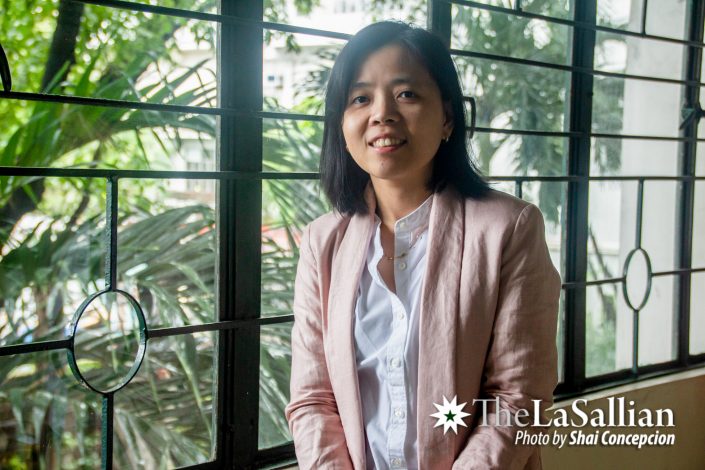For many, the mere mention of the word “math” induces a state of distress. From complex equations and unknown variables to intricate graphs and large chunks of data, working with numbers and other mystifying symbols can be quite an ordeal.
But for Dr. Angelyn Lao, math is powerful and fascinating, and it is a field that she hopes would pique the interest of—rather than intimidate—more individuals. Currently an Associate Professor from the DLSU Mathematics and Statistics Department and the College of Science’s Assistant Dean for Research and Advanced Studies, Lao acknowledges that it is a tall order to chip away at the hifalutin aura surrounding mathematics, and most science disciplines in general.
As an educator, Lao believes the answer lies in mentorship, with her advocacy revolving around “cultivating the passion for STEM (Science, Technology, Engineering, and Mathematics) exploration”, particularly among the youth.
Mathematical modeling
Guided by mentors like Dr. Eduardo Mendoza, a Corresponding Member of the National Academy of Science and Technology’s Mathematical and Physical Sciences Division, and Dr. Olaf Wolkenhauer, a data engineer from the University of Rostock in Germany whose research includes the use of computational methods to study cellular processes, Lao chooses “serendipity” to describe her venture into Systems Biology.
She discloses that she first encountered the discipline during a lecture given by Mendoza, who at that time was a Senior Research Scientist at the Ludwig Maximilian University of Munich while also serving as an Adjunct Professor of the University of the Philippines. Mendoza later introduced Lao to Wolkenhauer, opening up the opportunity to go abroad and pursue a doctorate degree in Systems Biology.
Systems Biology involves the creation and application of mathematical models that serve to explain the interactions between components of biological systems. Lao finds such an interdisciplinary prospect “interesting” as it allows her to explore the life sciences—which for her is unfamiliar territory—by using tools from her existing area of expertise: mathematics.
Choosing between pancreatic disorders and Alzheimer’s disease as the topic for her dissertation, Lao did not hesitate to decide to work on the latter since her grandmother had been diagnosed with the said condition. However, gratification did not come easy. Lao recounts trying an array of models to find the right combination of equations to describe the progression of Alzheimer’s disease in the human body based on existing experimental and clinical data. “Sa apat na yun, kahit anong gawin ko, nag-fit lang siya sa [tatlong parameters]; may isa palaging hindi nagfi-fit,” she explains.
(No matter what I did, the model would only fit three of the four parameters; there would always be one that would not fit.)
To this day, Lao considers her dissertation as her “most memorable” work, an accomplishment that allowed her to say, “I can do it on my own.” She later applied such computational methods to epidemiological studies—which aim to trace the factors affecting the spread of diseases in a given community—and used a model to predict whether an intervention or action changing one element of the system might help reduce the prevalence of infectious illnesses like tuberculosis in the country.

Messages to the youth
“To be excited and [to] remember that feeling [of excitement] in whatever you do [are] also very important to keep you going,” Lao advises, as she similarly remains excited about mathematical approaches intersecting with and pushing forward advancements in other research areas.
Her own journey—as well as plenty of other STEM professionals, whose now-bustling careers were certainly not built overnight—could inspire and encourage aspiring scientists. As Lao expresses, “I want to bring Filipino innovations and scientific works into the limelight.”
Having visible personas from the local scientific community can be a source of motivation for the youth to pursue careers in STEM. This could potentially help address the lack of scientists and the inadequacy of data in various research fields—a limitation that hindered Lao from adapting her Alzheimer’s model, which was instead based on foreign physiological data, to the Philippine context since bodily processes and interactions can vary per demographic and ethnicity.
Despite these constraints, Lao continues to find ways to contribute further to the local research scene, believing this to be “key for [the country] to succeed”. Aside from teaching, she also invites scholars from other disciplines to discuss their areas of expertise and tries to accommodate most requests to speak at seminars, remembering how one pivotal lecture influenced her career path just a decade ago.
“I make sure that I [am] able to deliver the following messages: the importance of being curious and the value of investigation, conducting research studies, to satisfy your curiosity…I try to create platforms where the students can be inspired,” Lao shares.
Molding the future
Her experiences as both a mentee and a mentor gave Lao all the more reason to push for the incorporation of young scientists into research teams. She also urges to increase the emphasis placed on education and research.
“Filipinos should believe that we can be really good [at] math and science,” Lao affirms, emphasizing the importance of making STEM fields more accessible. “We just need good resources, [the] right materials, and [a] conducive environment.”
She hopes to provide junior researchers with the foundation they need, a strong support system, and proper opportunities so that they, too, can become independent and competent professionals—prominent Filipino scientists who would be able to not only grow and excel in their respective disciplines, but also give back to the community by nurturing other individuals.
